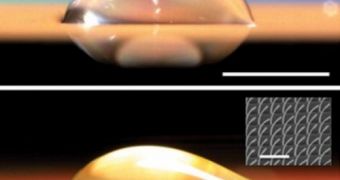In a groundbreaking new achievement, a team of scientists has been able to demonstrate a way of controlling the direction of a liquid's flow on a surface. This is the first time this is achieved, and the finding carries with it considerable implications for a wide array of research fields, including microfluidic and DNA microarray technologies, as well as for improvements in common objects such as ink-jet printers. Since the direction of the liquid can now be controlled, all these applications could experience innovations, the team behind the work says, quoted by PhysOrg.
The new finding comes from mechanical engineers based at the Massachusetts Institute of Technology (MIT), who say that the secret to this feat is controlling the actual surface. They explain that they made controlling liquids possible through the use of especially-devised, small structures, which they placed in a specific pattern on the surface of substrate materials. These materials in turn force the droplets to only move in a single direction, which the researchers dictate. Details of the methods used appear in the March 28 issue of the esteemed scientific publication Nature Materials.
Evelyn N. Wang, the Esther and Harold E. Edgerton assistant professor of mechanical engineering at the Institute, and graduate students Kuang-Han Chu and Rong Xiao, authored the investigation. The group says that their new approach is entirely passive, in the sense that no active mechanisms are employed to redirect droplets. The flow of liquids is based on the disposition of very small, inclined pillars, all at the nanoscale, which can restrict unwanted motions, and essentially act as channels. The end result is that any droplet, placed anywhere on that particular surface, will only travel in one direction.
“Nobody had really studied this kind of geometry, because it’s hard to fabricate,” Wang explains. “Droplet manipulation has been heavily developed for moving samples from station to station for different analysis steps,” says University of Illinois in Urbana-Champaign (UIUC) professor of mechanical science and engineering Mark Shannon. The MIT investigation was sponsored with grant money from the US National Science Foundation (NSF), the Defense Advanced Research Projects Agency (DARPA) and Northrup Grumman.

 14 DAY TRIAL //
14 DAY TRIAL //